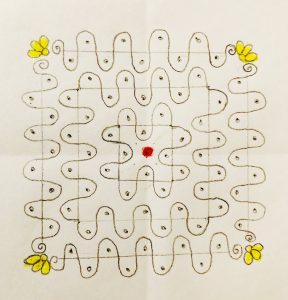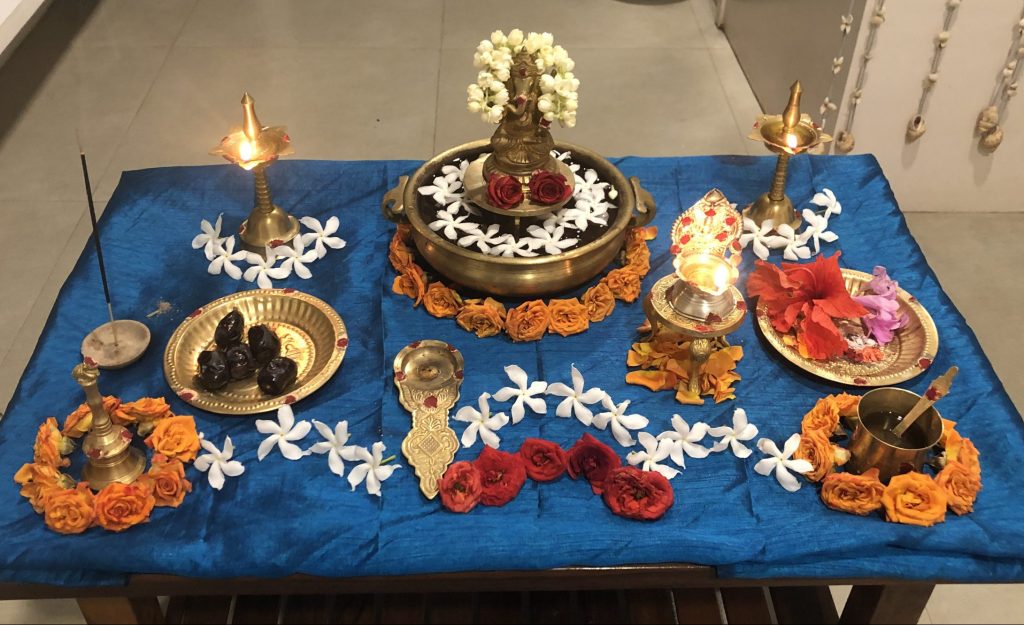asmin bimbe sri durga/ sri ganeshaH/sri vishnuH.. devaH dhyAyAmi, sri durga… devAm AvAhayAmi.
yAni kAni cha pApAni, sarvAntaH kritAnicha. tAni tAni vinashyanti, pradakshina pade pade.
yathA sthAnam pratishThApayAmi
shobhanArthe kshEmAya punaH AgamanAyacha
A dialogue between Sashikala Ananth and her student Shivangi
Yantra, Mantra & Tantra (YMT) is a simple procedure to bring out energetic shifts in a space. The actual pooja (Prayer or ritual) in the Hindu tradition is very elaborate. And usually, a person can perform it only when initiated by a GURU. Therefore, Sashi Ma’am with her experience and knowledge has created a very simple procedure by adapting the basic principles of a pooja for the ordinary uninitiated person. We are answering below some common questions, which are asked around this new procedure:
Can anybody perform it?
In her opinion, YMT is a simple method for bringing the larger or cosmic energies into a space and into ourselves. Therefore, anybody can perform this so long as they are willing to follow a procedure that is fairly regular and disciplined. Usually, she recommends one mandala or 42-49 days depending upon different traditions.
Should it be done continuously without a break?
Yes, it should be continuous but if there is a time limitation then we would suggest 21- 24days atleast which is half the mandala. It is important to find a suitable time of the day to perform regularly. Ideal times are early mornings or late evenings as these are the times known as Sandhi or point between darkness & light or light & darkness. It is always possible to choose any other time that is suitable for the person though the Sandhi times are more auspicious.
What do we need for performing this ritual?
Fundamentally, the idea is to create a sacred space in which this ritual may be performed. A table or a ledge can be used which is slightly raised from the ground so that the ritual performer is lower than the altar when seated. This is important that you are not looking down to the altar. So if you are sitting on the floor then the altar can be a little above your eye level while seated. Similarly, if you are standing then the altar can be a little above eye level while standing.
The elements for the ritual can be placed on a plate or on a cloth. This is to define the location of the votive object (that which is the sacred object). A specific image of any of the divine beings that one is familiar with should occupy the central space (it can be a picture, a 3 dimensional sculpture, a rock with specific characteristics that you feel are special or a temporary divine image created out of a handful of clay/ turmeric/ Sandal-paste). Around these small cups/ plates/ containers can be placed in an aesthetic fashion which will contain water, rice- grains, a little earth from the garden, flowers & Incense. An oil lamp or a candle may be used on one side of the image, ideally to the right side (from you). A bell should be placed on the left. If you have camphor then that can also be placed next to the lamp in a small container.
What are the YMT elements in this Altar?
In this Altar the image is the Yantra, all the other elements are offerings that represent the five elements (Fire, earth, air, water & space). The Mantra is whatever chant that you will offer while carrying out the ritual (Note that chanting can be learnt correctly if you are in doubt of the right method). If you don’t know any mantra, chanting Om continuously is good enough. Tantra becomes the daily preparation & process of the ritual and the process/ way in which the energy is brought down from the cosmic space into the Altar and into oneself.
Everyday, the water, flowers, incense, earth have to be replaced and after the completion of the ritual they should be offered back to the earth. The reason for this is that one is also invoking the beauty and the living nature of reality every time the prayer is being carried out. After the prayer all the elements in the ritual become energised & therefore should be offered back to the earth.
Usually, in the Hindu tradition there is also an offering of fruit or sweets which is consumed by the people performing the ritual after the completion of the ritual when they have also been energised. The water can also be sipped by the performer and others attending the ritual, what is left is offered back to the earth.
What is specific preparation for the performer?
Before the ritual it is important that the performer is on an empty stomach (if it is being performed in the evening that minimum 4 hours gap between the meal and the ritual so stomach is reasonably empty, and if it is performed in the morning then only water can be sipped before the ritual). It is also good to have had a bath prior to the ritual or atleast a wash (for face, hand and feet). After lighting the lamp it is important to sit quietly and breathe atleast 12 complete breaths while requesting the cosmic energies to enter into yourself and the image in the Altar. Then the chanting should be done for atleast 15 minutes with eyes closed so that the entire focus is on the energies that are being brought down without any visual distractions. At the end of 15 minutes, the bell can be rung, camphor burnt and then the energies shall be requested to go back to where they came from. These energies are meant for everyone and cannot be owned by us. Therefore, they have to be sent back with love.
How do I add to this process?
 All rituals of this type are very individualised or very specific to the individual. If you have access then you can bring in elements like a beautiful base cloth, brass plate, flower garlands, freshly prepared sweets, rangoli or kolam in front of the Altar, flowers in a vase and place in front of the Altar and so on. Singing and dancing can also be done while performing the ritual. Inviting your neighbours, friends, relatives and giving them offerings, having them be a part of the ritual can be an addition too as these rituals are never meant for self alone but for humanity and all of nature. (This is what is also referred to as vasudhaiva kutumbakam)
All rituals of this type are very individualised or very specific to the individual. If you have access then you can bring in elements like a beautiful base cloth, brass plate, flower garlands, freshly prepared sweets, rangoli or kolam in front of the Altar, flowers in a vase and place in front of the Altar and so on. Singing and dancing can also be done while performing the ritual. Inviting your neighbours, friends, relatives and giving them offerings, having them be a part of the ritual can be an addition too as these rituals are never meant for self alone but for humanity and all of nature. (This is what is also referred to as vasudhaiva kutumbakam)
It is important to bring it in as your specific offering. Fundamentally, these rituals are:
- To request the energies to flow through our space
- To bring it alive to answer some of our doubts, fear & anxiety and put them to rest.
- To celebrate the very nature of life as a personal rejoicing.
Should it be stopped after one Mandala?
If you find a great deal of happiness, inner delight and a form of well-being then this can very well become a part of your daily life and can be continued endlessly.
Please note the benefits from such a ritual can only be felt and experienced and cannot be measured. It is important that you perform a ritual for yourself before doing it for others.



 Priya is a Yoga therapist in the Krishnamacharya tradition. She adapts Reiki & energy work, Vedic chanting, life coaching & Ayurvedic practices in her healing spaces. She is committed to nurturing collectives that have the praxis of Yoga at their heart.
Priya is a Yoga therapist in the Krishnamacharya tradition. She adapts Reiki & energy work, Vedic chanting, life coaching & Ayurvedic practices in her healing spaces. She is committed to nurturing collectives that have the praxis of Yoga at their heart. Anisha has been on an exploration to understand herself through yoga for the last 15years which led her to teaching yoga, yoga therapy and inner work through yoga.
Anisha has been on an exploration to understand herself through yoga for the last 15years which led her to teaching yoga, yoga therapy and inner work through yoga. Apoorva chanced upon Yoga in her early 20s. A spark was lit within and there was no turning back. Her exploration led her to the Krishnamacharya tradition more than a decade ago. Curious about human behaviour and what drives it, she was thrilled when her search ended (and also began) when she first came upon the Yoga Sutra, which illuminated a path towards answering many questions that had been held for a long time.
Apoorva chanced upon Yoga in her early 20s. A spark was lit within and there was no turning back. Her exploration led her to the Krishnamacharya tradition more than a decade ago. Curious about human behaviour and what drives it, she was thrilled when her search ended (and also began) when she first came upon the Yoga Sutra, which illuminated a path towards answering many questions that had been held for a long time. Anita is a yoga teacher and therapist in the tradition of Sri.T.Krishnamacarya and Sri T.K.V. Desikachar, a Reiki practitioner and a Life Coach. She is also the founder of Vishoka, a center for learning Indic and energy-based frameworks for living and healing. Her deep concern for human suffering and the problems of unsustainable living kept her on the path of seeking an integrated approach to looking at life, living, learning and healing.
Anita is a yoga teacher and therapist in the tradition of Sri.T.Krishnamacarya and Sri T.K.V. Desikachar, a Reiki practitioner and a Life Coach. She is also the founder of Vishoka, a center for learning Indic and energy-based frameworks for living and healing. Her deep concern for human suffering and the problems of unsustainable living kept her on the path of seeking an integrated approach to looking at life, living, learning and healing. Ankit is a seeker in the wisdom traditions of India. The core of his work includes creating dialogic spaces where people can look within and see the connection between their inner and outer lives. Inspired by the likes of Gandhi, Aurobindo, Vivekananda and Guru Gobind his experiments in service took him back to his roots in Punjab where he is creating a community-led model of higher education which is open, inclusive and accessible for all. Ritambhara for him is a space for engaging in a community which is committed to a DHramic life. He anchors his work of learning and leadership in the Antaranga Yoga Sadhana and the humanistic wisdom of Mahabharata.
Ankit is a seeker in the wisdom traditions of India. The core of his work includes creating dialogic spaces where people can look within and see the connection between their inner and outer lives. Inspired by the likes of Gandhi, Aurobindo, Vivekananda and Guru Gobind his experiments in service took him back to his roots in Punjab where he is creating a community-led model of higher education which is open, inclusive and accessible for all. Ritambhara for him is a space for engaging in a community which is committed to a DHramic life. He anchors his work of learning and leadership in the Antaranga Yoga Sadhana and the humanistic wisdom of Mahabharata.